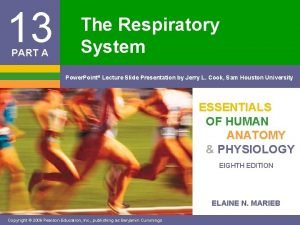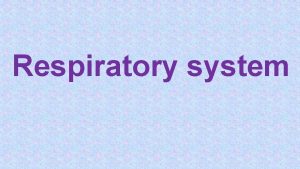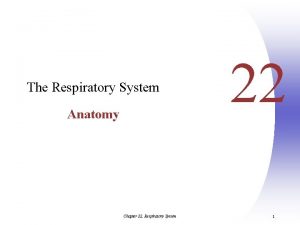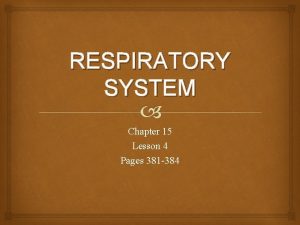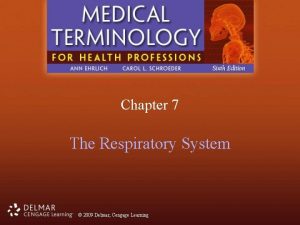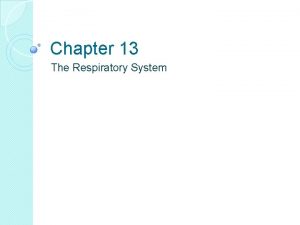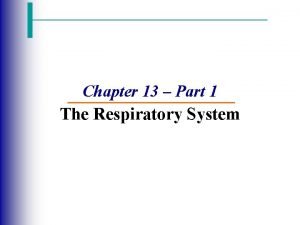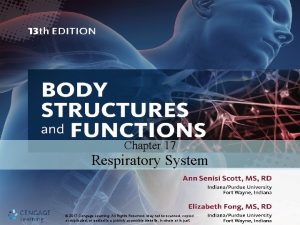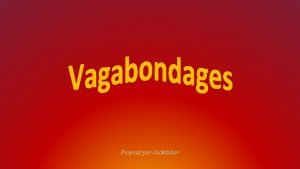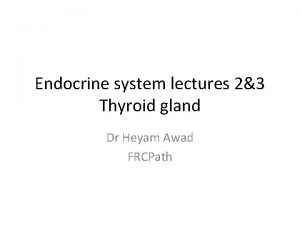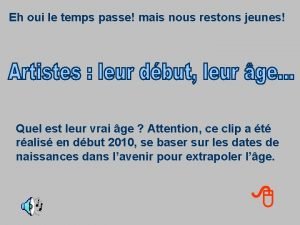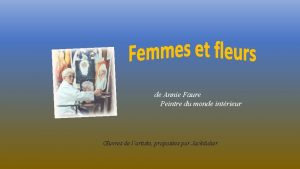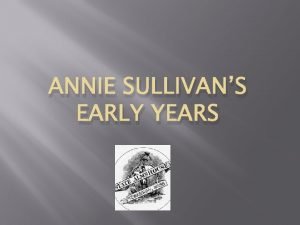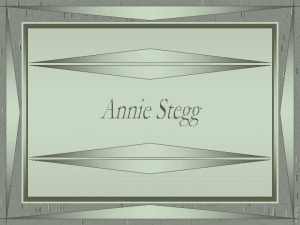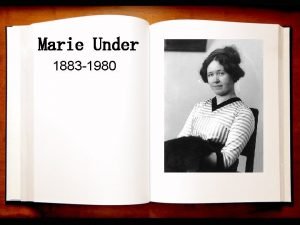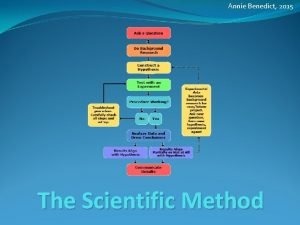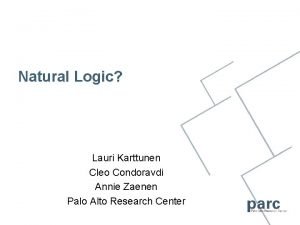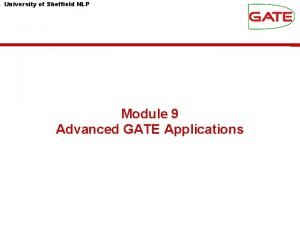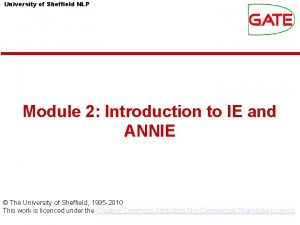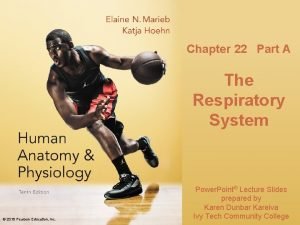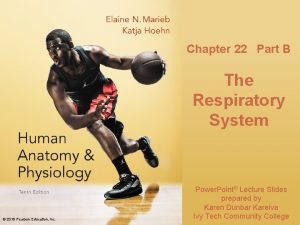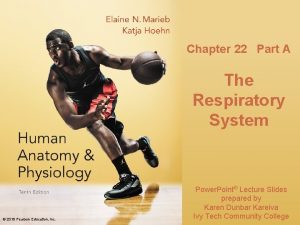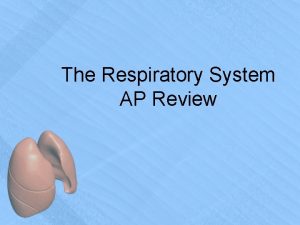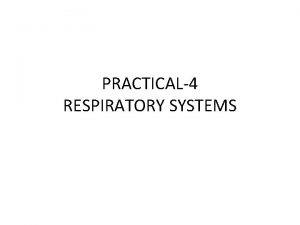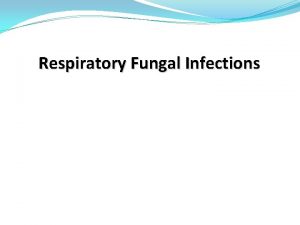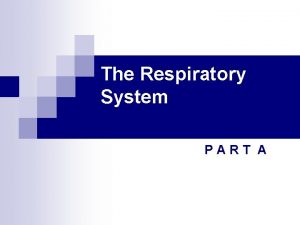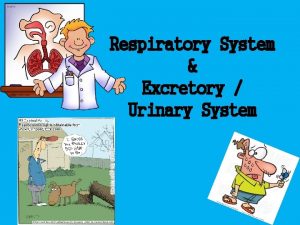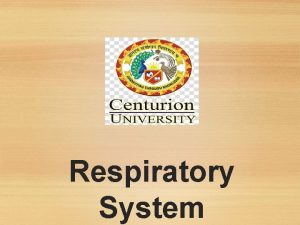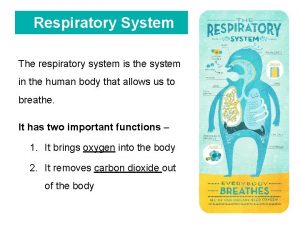Chapter 22 Part A The Respiratory System Annie

































































- Slides: 65

Chapter 22 Part A The Respiratory System © Annie Leibovitz/Contact Press Images © 2016 Pearson Education, Inc. Power. Point® Lecture Slides prepared by Karen Dunbar Kareiva Ivy Tech Community College

Table 22. 1 The Upper Respiratory System © 2016 Pearson Education, Inc.

Table 22. 2 The Lower Respiratory System © 2016 Pearson Education, Inc.

Respiratory System • Major functions of respiratory system: supply body with O 2 for cellular respiration and dispose of CO 2, a waste product of cellular respiration • Respiratory and circulatory system are closely coupled • Also functions in olfaction and speech © 2016 Pearson Education, Inc.

Respiratory System • Respiration involves four processes 1. Pulmonary ventilation (breathing): movement of air into and out of lungs 2. External respiration: exchange of O 2 and CO 2 between lungs and blood 3. Transport of O 2 and CO 2 in blood 4. Internal respiration: exchange of O 2 and CO 2 between systemic blood vessels and tissues © 2016 Pearson Education, Inc. Respiratory system Circulatory system

Part 1 Functional Anatomy • Major organs – Nose and nasal cavity – Paranasal sinuses – Pharynx – Larynx – Trachea – Bronchi and branches – Lungs and alveoli © 2016 Pearson Education, Inc. Upper respiratory Lower respiratory

• https: //www. youtube. com/watch? v=b. HZsv. Bd. UC 2 I © 2016 Pearson Education, Inc.

Figure 22. 1 The major respiratory organs in relation to surrounding structures. Nasal cavity Nostril Oral cavity Pharynx Larynx Trachea Carina of trachea Right main (primary) bronchus Right lung © 2016 Pearson Education, Inc. Left main (primary) bronchus Left lung Diaphragm

22. 1 Upper Respiratory System The Nose and Paranasal Sinuses • Functions of nose – Provides an airway for respiration – Moistens and warms entering air – Filters and cleans inspired air – Serves as resonating chamber for speech – Houses olfactory receptors • Divided into two regions: external nose and nasal cavity © 2016 Pearson Education, Inc.

The Nose and Paranasal Sinuses (cont. ) • External nose – Areas include: root (area between eyebrows); bridge, dorsum nasi (anterior margin), and apex (tip of nose) – Nostrils (nares): bounded laterally by alae – External nose is formed by: • Nasal and frontal bones superiorly—form bridge and root, respectively • Maxillary bones laterally • Plates of hyaline cartilage inferiorly © 2016 Pearson Education, Inc.

Figure 22. 2 a The external nose. Epicranius, frontal belly Root and bridge of nose Dorsum nasi Ala of nose Apex of nose Naris (nostril) Surface anatomy © 2016 Pearson Education, Inc.

Figure 22. 2 b The external nose. Frontal bone Nasal bone Septal cartilage Maxillary bone (frontal process) Lateral process of septal cartilage Minor alar cartilages Dense fibrous connective tissue Major alar cartilages External skeletal framework © 2016 Pearson Education, Inc.

The Nose and Paranasal Sinuses (cont. ) • Nasal cavity – Found within and posterior to external nose – Divided by midline nasal septum – Posterior nasal apertures (choanae): opening where nasal cavity turns into nasopharynx – Roof: formed by ethmoid and sphenoid bones – Floor: formed by hard palate (bone) and soft palate (muscle) © 2016 Pearson Education, Inc.

The Nose and Paranasal Sinuses (cont. ) • Nasal cavity (cont. ) – Nasal vestibule: nasal cavity superior to nostrils • Rest of nasal cavity lined with mucous membranes – Olfactory mucosa: lines superior region of nasal cavity and contains olfactory epithelium – Respiratory mucosa: pseudostratified ciliated columnar epithelium that contains goblet cells and rests on lamina propria that contains many seromucous nasal glands © 2016 Pearson Education, Inc.

The Nose and Paranasal Sinuses (cont. ) – Nasal conchae • Scroll-like, mucosa-covered projections that protrude medially from each lateral wall of nasal cavity • Shape of conchae help to: – Increase mucosal area – Enhance air turbulence • Functions of conchae – During inhalation, conchae and nasal mucosa: » Filter, heat, and moisten air – During exhalation these structures: » Reclaim heat and moisture © 2016 Pearson Education, Inc.

The Nose and Paranasal Sinuses (cont. ) • Paranasal sinuses – Paranasal sinuses form ring around nasal cavities – Located in frontal, sphenoid, ethmoid, and maxillary bones – Functions • Lighten skull • Secrete mucus • Help to warm and moisten air © 2016 Pearson Education, Inc.

Figure 22. 3 a The nasal cavity. Posterior nasal aperture Sphenoidal sinus Cribriform plate of ethmoid bone Frontal sinus Nasal cavity • Nasal conchae (superior, middle and inferior) • Nasal meatuses (superior, middle, and inferior) • Nasal vestibule • Nostril Uvula © 2016 Pearson Education, Inc. Soft palate Tongue Hard palate

Figure 22. 3 b The nasal cavity. Olfactory epithelium Olfactory nerves Nasal cavity • Nasal conchae (superior, middle and inferior) • Nasal meatuses (superior, middle, and inferior) Tubal tonsil Opening of pharyngotympanic (auditory) tube © 2016 Pearson Education, Inc. Uvula Soft palate Hard palate Nasal vestibule

The Pharynx • Pharynx: funnel-shaped muscular tube that runs from base of skull to vertebra C 6 – Connects nasal cavity and mouth to larynx and esophagus – Composed of skeletal muscle • Three regions – Nasopharynx – Oropharynx – Laryngopharynx © 2016 Pearson Education, Inc.

Figure 22. 4 a The pharynx, larynx, and upper trachea. Nasopharynx Oropharynx Laryngopharynx Regions of the pharynx © 2016 Pearson Education, Inc.

The Pharynx (cont. ) • Nasopharynx – Air passageway posterior to nasal cavity – Lining contains pseudostratified columnar epithelium – Pharyngeal tonsils (adenoids) located on posterior wall – Function: traps & destroys airborne pathogens • Oropharynx – Passageway for food and air from level of soft palate to epiglottis – Lining consists of stratified squamous epithelium – Palatine tonsils located in lateral walls of fauces – Lingual tonsil located on posterior surface of tongue © 2016 Pearson Education, Inc.

The Pharynx (cont. ) • Laryngopharynx – Passageway for food and air – Posterior to upright epiglottis – Extends to larynx, where it is continuous with esophagus – Lined with stratified squamous epithelium © 2016 Pearson Education, Inc.

Figure 22. 4 b The pharynx, larynx, and upper trachea. Posterior nasal aperture Nasopharynx • Pharyngeal tonsil • Opening of pharyngotympanic tube Oropharynx • Palatine tonsil • Isthmus of the fauces Hard palate Soft palate Tongue Lingual tonsil Laryngopharynx Esophagus Trachea (b) Structures of the pharynx and larynx © 2016 Pearson Education, Inc. Larynx • Epiglottis • Vestibular fold • Thyroid cartilage • Vocal fold • Cricoid cartilage Thyroid gland Hyoid bone

22. 2 Lower Respiratory System • Lower respiratory system consists of: – Larynx, trachea, bronchi, and lungs • Broken into two zones – Respiratory zone: site of gas exchange • Consists of microscopic structures such as respiratory bronchioles, alveolar ducts, and alveoli – Conducting zone: conduits that tranport gas to and from gas exchange sites • Includes all other respiratory structures • Cleanses, warms, and humidifies air © 2016 Pearson Education, Inc.

The Larynx • Basic anatomy – Larynx (voice box) extends from 3 rd to 6 th cervical vertebra and attaches to hyoid bone – Opens into laryngopharynx and is continuous with trachea – Three functions of larynx: 1. Provides patent airway 2. Routes air and food into proper channels 3. Voice production – Houses vocal folds © 2016 Pearson Education, Inc.

The Larynx (cont. ) • Framework of larynx consists of nine hyaline cartilages (except for epiglottis), connected by membranes and ligaments 1. Thyroid cartilage: large, shield-shaped cartilage that contains laryngeal prominence (Adam’s apple) 2. Cricoid cartilage: ring-shaped 3. & 4. Paired arytenoid cartilages 5. & 6. Paired cuneiform cartilages 7. & 8. Paired corniculate cartilages 9. Epiglottis © 2016 Pearson Education, Inc.

The Larynx (cont. ) • Epiglottis – Consists of elastic cartilage (not hyaline) – Covers laryngeal inlet during swallowing – Covered in taste bud–containing mucosa © 2016 Pearson Education, Inc.

Figure 22. 5 a The larynx. Body of hyoid bone Laryngeal prominence (Adam’s apple) Cricoid cartilage Sternal head Clavicular head Clavicle Jugular notch Surface view © 2016 Pearson Education, Inc. Sternocleidomastoid

Figure 22. 5 b The larynx. Epiglottis Thyrohyoid membrane Body of hyoid bone Thyroid cartilage Laryngeal prominence (Adam’s apple) Cricothyroid ligament Cricoid cartilage Cricotracheal ligament Tracheal cartilages Anterior view © 2016 Pearson Education, Inc.

The Larynx (cont. ) – Vocal folds • Vocal ligaments: form core of vocal folds (true vocal cords) • Contain elastic fibers that appear white because of lack of blood vessels • Glottis: opening between vocal folds • Folds vibrate to produce sound as air rushes up from lungs © 2016 Pearson Education, Inc.

Figure 22. 5 c The larynx. Epiglottis Hyoid bone Thyrohyoid membrane Corniculate cartilage Thyroid cartilage Arytenoid cartilage Cricoid cartilage Glottis Tracheal cartilages Photograph of cartilaginous framework of the larynx, posterior view © 2016 Pearson Education, Inc.

Figure 22. 5 d The larynx. Epiglottis Body of hyoid bone Thyrohyoid membrane Cuneiform cartilage Corniculate cartilage Fatty pad Arytenoid cartilage Vestibular fold (false vocal cord) Arytenoid muscle Thyroid cartilage Cricoid cartilage Vocal fold (true vocal cord) Cricothyroid ligament Tracheal cartilages Cricotracheal ligament Sagittal section (anterior on the right) © 2016 Pearson Education, Inc.

Figure 22. 6 Movements of the vocal folds. Epiglottis Vestibular fold (false vocal cord) Vocal fold (true vocal cord) Glottis Inner lining of trachea Cuneiform cartilage Corniculate cartilage Vocal folds in closed position; closed glottis © 2016 Pearson Education, Inc. Vocal folds in open position; open glottis

The Larynx (cont. ) • Voice production – Speech: intermittent release of expired air during opening and closing of glottis – Pitch is determined by length and tension of vocal cords – Loudness depends upon force of air © 2016 Pearson Education, Inc.

The Larynx (cont. ) • Sphincter functions of the larynx – Vocal folds may act as sphincter to prevent air passage – Example: Valsalva’s maneuver • • Glottis closes to prevent exhalation Abdominal muscles contract Intra-abdominal pressure rises Helps to empty rectum or stabilizes trunk during heavy lifting © 2016 Pearson Education, Inc.

The Trachea • Trachea (windpipe) extends from larynx into mediastinum, where it divides into two main bronchi • Wall composed of three layers – Mucosa: ciliated epithelium with goblet cells – Submucosa: connective tissue; prevent collapse of trachea – Adventitia: outermost layer made of connective tissue © 2016 Pearson Education, Inc.

The Trachea (cont. ) • Trachealis – Consists of smooth muscle fibers; contracts during coughing to expel mucus • Carina – Last tracheal cartilage that is expanded and found at point where trachea branches into two main bronchi – Mucosa of carina highly sensitive • Violent coughing will be triggered if any foreign object makes contact with it © 2016 Pearson Education, Inc.

Figure 22. 7 a Tissue composition of the tracheal wall. Posterior Esophagus Trachealis Mucosa Submucosa Lumen of trachea Seromucous gland in submucosa Hyaline cartilage Adventitia Anterior Cross section of the trachea and esophagus © 2016 Pearson Education, Inc.

Figure 22. 7 b Tissue composition of the tracheal wall. Goblet cell Mucosa • Pseudostratified ciliated columnar epithelium • Lamina propria (connective tissue) Submucosa Seromucous gland in submucosa Hyaline cartilage Photomicrograph of the tracheal wall (320 ) © 2016 Pearson Education, Inc.

Figure 22. 7 c Tissue composition of the tracheal wall. Scanning electron micrograph of cilia in the trachea (2500 ) © 2016 Pearson Education, Inc.

The Bronchi and Subdivisions • Air passages undergo 23 orders of branching – Branching referred to as bronchial tree • From tips of bronchial tree: – Conducting zone structures give rise to respiratory zone structures © 2016 Pearson Education, Inc.

The Bronchi and Subdivisions (cont. ) • Conducting zone structures – Trachea divides to form right and left main (primary) bronchi – Each main bronchus enters hilum of one lung – Each main bronchus then branches into lobar (secondary) bronchi • Three on right and two on left © 2016 Pearson Education, Inc.

The Bronchi and Subdivisions (cont. ) • Conducting zone structures (cont. ) – Each lobar bronchus branches into segmental (tertiary) bronchi • Segmental bronchi divide repeatedly – Branches become smaller and smaller • Bronchioles: less than 1 mm in diameter • Terminal bronchioles: smallest of all branches – Less than 0. 5 mm in diameter © 2016 Pearson Education, Inc.

Figure 22. 8 Conducting zone passages. Trachea Superior lobe of left lung Left main (primary) bronchus Superior lobe of right lung Lobar (secondary) bronchus Middle lobe of right lung Segmental (tertiary) bronchus Inferior lobe of right lung Inferior lobe of left lung © 2016 Pearson Education, Inc.

The Bronchi and Subdivisions (cont. ) • Conducting zone structures (cont. ) – In conducting zone, from bronchi to bronchioles, changes occur • The supportive cartilage changes in character until it is no longer present in the bronchioles. – The mucosal epithelium transitions from pseudostratified columnar, to columnar, and finally, to cuboidal in the terminal bronchioles. – The relative amount of smooth muscle in the walls increases, allowing significant changes in resistance to airflow in the smaller airways. © 2016 Pearson Education, Inc.

The Bronchi and Subdivisions (cont. ) • Respiratory zone structures – Respiratory zone begins where terminal bronchioles feed into respiratory bronchioles, which lead into alveolar ducts and finally into alveolar sacs (saccules) • Alveolar sacs contain clusters of alveoli – ~300 million alveoli make up most of lung volume – Sites of actual gas exchange © 2016 Pearson Education, Inc.

Figure 22. 9 a Respiratory zone structures. Alveoli Alveolar duct Respiratory bronchioles Terminal bronchiole © 2016 Pearson Education, Inc. Alveolar duct Alveolar sac

Figure 22. 9 b Respiratory zone structures. Respiratory bronchiole Alveolar duct Alveoli Alveolar sac © 2016 Pearson Education, Inc. Alveolar pores

The Bronchi and Subdivisions (cont. ) – Respiratory membrane • Blood air barrier that consists of alveolar and capillary walls along with their fused basement membranes – Very thin (~0. 5 m); allows gas exchange across membrane by simple diffusion • Alveolar walls consist of: – Single layer of squamous epithelium (type I alveolar cells) – Scattered cuboidal type II alveolar cells secrete surfactant and antimicrobial proteins © 2016 Pearson Education, Inc.

The Bronchi and Subdivisions (cont. ) – Respiratory membrane (cont. ) • Other significant features of alveoli: 1. Surrounded by fine elastic fibers and pulmonary capillaries 2. Alveolar pores connect adjacent alveoli » Equalize air pressure throughout lung » Provide alternate routes in case of blockages 3. Alveolar macrophages keep alveolar surfaces sterile » 2 million dead macrophages/hour carried by cilia to throat and swallowed © 2016 Pearson Education, Inc.

Figure 22. 10 a Alveoli and the respiratory membrane. Terminal bronchiole Respiratory bronchiole Smooth muscle Elastic fibers Alveolus Capillaries Diagrammatic view of capillary-alveoli relationships © 2016 Pearson Education, Inc.

Figure 22. 10 b Alveoli and the respiratory membrane. Scanning electron micrograph of pulmonary capillary casts (300 ) © 2016 Pearson Education, Inc.

Figure 22. 10 c Alveoli and the respiratory membrane. Red blood cell Nucleus of type I alveolar cell Alveolar pores Capillary O 2 Capillary CO 2 Macrophage Alveolus Endothelial cell nucleus Alveolar epithelium Respiratory membrane Fused basement membranes of alveolar epithelium and capillary endothelium Capillary endothelium Alveoli (gas-filled air spaces) Red blood cell in capillary Type II alveolar cell (secretes surfactant) Detailed anatomy of the respiratory membrane © 2016 Pearson Education, Inc. Type I alveolar cell

22. 3 Lungs and Pleurae Gross Anatomy of the Lungs • Lungs occupy all of the thoracic cavity except for mediastinum • Root: site of vascular and bronchial attachment to mediastinum • Costal surface: anterior, lateral, and posterior surfaces • Apex: superior tip, deep to clavicle • Base: inferior surface that rests on diaphragm © 2016 Pearson Education, Inc.

Gross Anatomy of the Lungs (cont. ) • Hilum: found on mediastinal surface, it is the site for entry/exit of blood vessels, bronchi, lymphatic vessels, and nerves • Left lung: separated into superior and inferior lobes by oblique fissure – Smaller than right because of position of heart • Right lung: separated into superior, middle, and inferior lobes • Superior and middle lobes separated by horizontal fissure • Middle and inferior lobes separated by oblique fissure © 2016 Pearson Education, Inc.

Figure 22. 11 a Anatomical relationships of organs in the thoracic cavity. Lung Trachea Thymus Apex of lung Right superior lobe Horizontal fissure Right middle lobe Oblique fissure Intercostal muscle Rib Parietal pleura Pleural cavity Visceral pleura Left superior lobe Oblique fissure Left inferior lobe Right inferior lobe Heart (in mediastinum) Diaphragm Base of lung Cardiac notch Anterior view. The lungs flank mediastinal structures laterally. © 2016 Pearson Education, Inc.

Figure 22. 11 b Anatomical relationships of organs in the thoracic cavity. Apex of lung Pulmonary artery Left superior lobe Oblique fissure Left inferior lobe Hilum of lung Aortic impression Left main bronchus Pulmonary vein Cardiac impression Oblique fissure Lobules Photograph of medial view of the left lung. © 2016 Pearson Education, Inc.

Figure 22. 11 c Anatomical relationships of organs in the thoracic cavity. Vertebra Posterior Esophagus (in mediastinum) Root of lung at hilum • Left main bronchus Right lung • Left pulmonary artery Parietal pleura • Left pulmonary vein Visceral pleura Left lung Pleural cavity Thoracic wall Pulmonary trunk Pericardial membranes Heart (in mediastinum) Anterior mediastinum Sternum Anterior Transverse section through the thorax, viewed from above. Lungs, pleural membranes, and major organs in the mediastinum are shown. © 2016 Pearson Education, Inc.

Gross Anatomy of the Lungs (cont. ) • Each lobe further divided into bronchopulmonary segments – 10 on right and 8– 10 on left – Separated by connective tissue septa – Each segment is served by its own artery, vein, and bronchus © 2016 Pearson Education, Inc.

Gross Anatomy of the Lungs (cont. ) • Lobules: smallest subdivisions visible to naked eye; hexagonal segments served by bronchioles and their branches • Lungs are mostly composed of alveoli; the rest consists of stroma, elastic connective tissue – Makes lungs very elastic and spongy © 2016 Pearson Education, Inc.

Figure 22. 12 A cast of the bronchial tree. Right lung Right superior lobe (3 segments) Left lung Left superior lobe (4 segments) Right middle lobe (2 segments) Right inferior lobe (5 segments) © 2016 Pearson Education, Inc. Left inferior lobe (5 segments)

Blood Supply and Innervation of Lungs • Lungs are perfused by two circulations 1. Pulmonary circulation • Pulmonary arteries deliver systemic venous blood from heart to lungs for oxygenation – Branch profusely to feed into pulmonary capillary networks • Pulmonary veins carry oxygenated blood from respiratory zones back to heart 2. Bronchial circulation • Bronchial arteries provide oxygenated blood to lung tissue © 2016 Pearson Education, Inc.

Blood Supply and Innervation of Lungs (cont. ) • Innervation of the lungs – Lungs are innervated by parasympathetic and sympathetic motor fibers, as well as visceral sensory fibers – Parasympathetic fibers cause bronchoconstriction, whereas sympathetic fibers cause bronchodilation © 2016 Pearson Education, Inc.

The Pleurae • Pleurae: thin, double-layered serosal membrane that divides thoracic cavity into two pleural compartments and mediastinum – Parietal pleura: membrane on thoracic wall, superior face of diaphragm, around heart, and between lungs – Visceral pleura: membrane on external lung surface – Pleural fluid fills slitlike pleural cavity between two pleurae • Provides lubrication and surface tension that assists in expansion and recoil of lungs © 2016 Pearson Education, Inc.

Figure 22. 11 c Anatomical relationships of organs in the thoracic cavity. Vertebra Posterior Esophagus (in mediastinum) Root of lung at hilum • Left main bronchus Right lung • Left pulmonary artery Parietal pleura • Left pulmonary vein Visceral pleura Left lung Pleural cavity Thoracic wall Pulmonary trunk Pericardial membranes Heart (in mediastinum) Anterior mediastinum Sternum Anterior Transverse section through the thorax, viewed from above. Lungs, pleural membranes, and major organs in the mediastinum are shown. © 2016 Pearson Education, Inc.
 Respiratory zone of the respiratory system
Respiratory zone of the respiratory system Respiratory digestive and circulatory system
Respiratory digestive and circulatory system Epliglottis
Epliglottis Part of the respiratory system
Part of the respiratory system Part of respiratory system
Part of respiratory system Tiny air sacs at the end of the bronchioles
Tiny air sacs at the end of the bronchioles Circulatory system and respiratory system work together
Circulatory system and respiratory system work together Chapter 7:10 respiratory system
Chapter 7:10 respiratory system Chapter 13 the respiratory system
Chapter 13 the respiratory system Respiratory system
Respiratory system The parts of the respiratory system in order
The parts of the respiratory system in order Chapter 7 the respiratory system labeling exercises
Chapter 7 the respiratory system labeling exercises Chapter 34 section 2 the respiratory system
Chapter 34 section 2 the respiratory system Respiratory system organs
Respiratory system organs Chapter 13 respiratory system worksheet
Chapter 13 respiratory system worksheet Chapter 17 respiratory system workbook answers
Chapter 17 respiratory system workbook answers Annie hudson bristol
Annie hudson bristol Annie prasad
Annie prasad Annie faure peintre
Annie faure peintre Annie faure peintre
Annie faure peintre Dillard essay
Dillard essay Annie chapman
Annie chapman Orphan annie eye nuclei
Orphan annie eye nuclei Annie chancel
Annie chancel Annie faure peintre
Annie faure peintre Demi moore, culver city, california, 1991
Demi moore, culver city, california, 1991 Annie sullivan's brother
Annie sullivan's brother Annie stegg
Annie stegg Annie o'connor physical therapist
Annie o'connor physical therapist Interesting facts about annie leibovitz
Interesting facts about annie leibovitz Annie leibovitz influences
Annie leibovitz influences Annie gilbert
Annie gilbert Annie dubuisson
Annie dubuisson Annie beghin
Annie beghin A r collection
A r collection Annie reiniusson
Annie reiniusson Annie leibovitz romeo and juliet
Annie leibovitz romeo and juliet Annie faure peintre
Annie faure peintre Annie leibovitz album covers
Annie leibovitz album covers Tinker creek meaning in malayalam
Tinker creek meaning in malayalam Annie faure peintre
Annie faure peintre Non parallel sentence
Non parallel sentence Annie thach
Annie thach Annie hag
Annie hag Annie gunner logan
Annie gunner logan Annie jump cannon quotes
Annie jump cannon quotes Annie hough
Annie hough Anakan skywalker
Anakan skywalker Annie bell fragrances
Annie bell fragrances Annie faure peintre
Annie faure peintre Annie marie adson
Annie marie adson Annie de jong
Annie de jong Annie euros
Annie euros Annie ipka
Annie ipka Annie salich education
Annie salich education Annie enia
Annie enia Annie fine cste
Annie fine cste Annie witte
Annie witte Annie benedict
Annie benedict Annie jump cannon
Annie jump cannon Annie austin manchester
Annie austin manchester Annie antoine
Annie antoine Annie zaenen
Annie zaenen Annie vinter
Annie vinter Annie nlp
Annie nlp Annie nlp
Annie nlp



